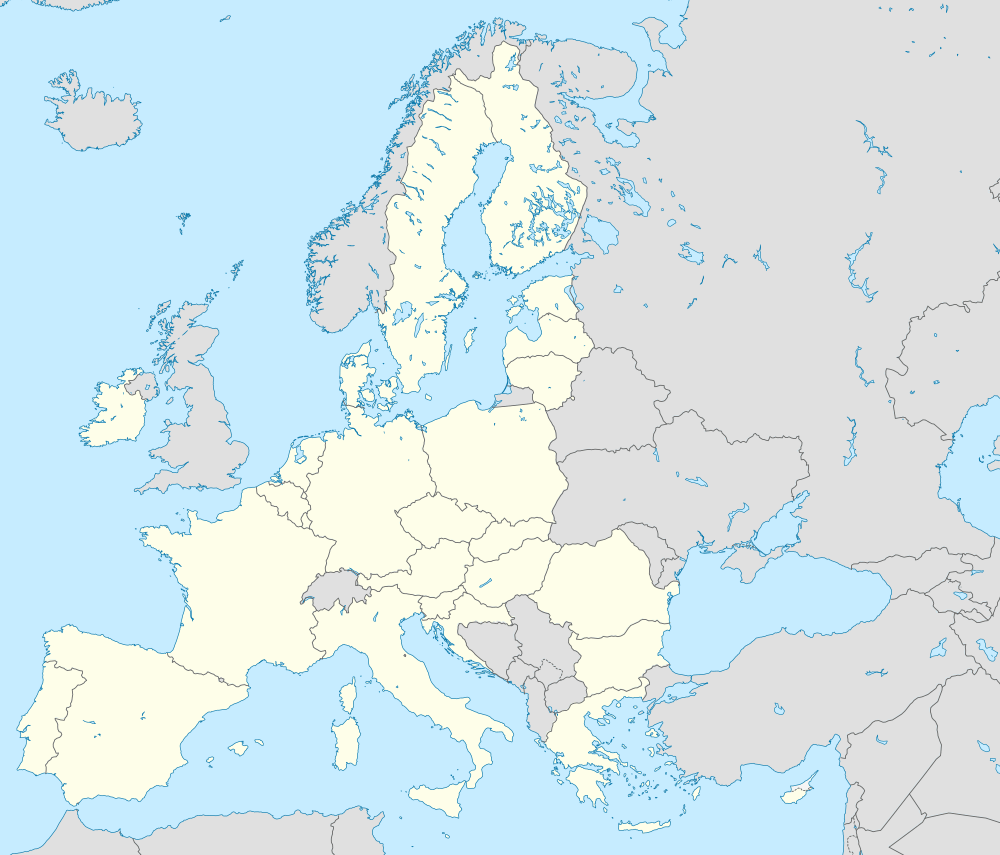European Aviation Safety Agency
The European Union Aviation Safety Agency (EASA) is an agency of the European Union (EU) with responsibility for civil aviation safety. It carries out certification, regulation and standardisation and also performs investigation and monitoring.[2]:§4.3 It collects and analyses safety data, drafts and advises on safety legislation and co-ordinates with similar organisations in other parts of the world.[2]:§4.3
 | |
 The offices of the agency in Cologne, Germany | |
| Agency overview | |
|---|---|
| Formed | 12 July 2002 |
| Jurisdiction | European Union and EFTA members[1] United Kingdom (until December 31, 2020) |
| Headquarters | Cologne, Germany |
| Agency executive |
|
| Key document | |
| Website | easa |
| Map | |
 Cologne European Aviation Safety Agency (European Union) | |
The idea of a European-level aviation safety authority goes back to 1996, but the agency was legally established only in 2002; it began its work in 2003.[2]:§4.3
Legal status
Based in Cologne, Germany, the agency was created on 15 July 2002,[3] and reached full functionality in 2008,[4] taking over functions of the Joint Aviation Authorities. European Free Trade Association countries have been granted participation in the agency. The United Kingdom will also remain a member until the end of the Brexit transition period on 31 December 2020.
The responsibilities of the agency include the analysis and research of safety parameters, authorizing foreign operators, and advising the European Commission on the drafting of EU legislation. It also implements and monitors safety rules (including inspections in the member states), gives type certification of aircraft and components, and approves organisations involved in the design, manufacture and maintenance of aeronautical products.
As part of Single European Sky II (SES-II), an initiative to standardize and coordinate all air traffic control over the EU, the agency has been given additional tasks,[5] which were implemented before 2013.[6][7] Since 4 December 2012, EASA is able to certify functional airspace blocks if more than three parties are involved.[7]
Jurisdiction
EASA has jurisdiction over new type certificates and other design-related airworthiness approvals for aircraft, engines, propellers and parts. EASA works with the EU member states' national aviation authorities (NAAs) but has taken over many of their functions in the interest of aviation standardisation across the EU and in the non-EU member Turkey.[8] EASA is also responsible for assisting the European Commission in negotiating international harmonisation agreements with the "rest of the world" on behalf of the EU member states, and it concludes technical agreements at a working level directly with its counterparts around the world such as the US Federal Aviation Administration (FAA). EASA also sets policy for aeronautical repair stations (Part 145 organisations in Europe and the US, also known as Part 571 organisations in Canada) and issues repair station certificates for repair stations located outside the EU, which permit foreign repair stations to perform work that is acceptable to the EU on its aircraft). EASA has developed regulations for air operations, flight crew licensing and non-EU aircraft used in the EU, which applied since the required European legislation to expand the agency's remit entered into force. The legislation was published on 19 March 2008.[9]
As a result of Brexit, the United Kingdom will leave EASA at the end of 2020.[10]
Criticism
In 2012, the European Court of Auditors (ECA) found that the agency did not have an agency-specific conflict of interest policy and procedures. EASA did not obtain or assess the declarations of interest for staff, management board, board of appeal and experts.[11] In its report, ECA declared that:
The worst performer among the four was the EASA, based in Cologne, which failed in all four areas that the report analyzed – on experts, staff, management board, and board of appeals.[12]
It was recommended that the organization adopt its own ethical standards because the then-existing condition exposed the agency to a substantial crisis of credibility as well as the incidence of favoritism and conflict of interest. For member-countries and other stakeholders, fairness is of paramount importance. This is because the European Union has been increasingly strengthening EASA's role, giving the agency independence. A discussion regarding the permission for the agency to impose financial penalties for safety violations is also underway.[13]
Member states
In addition to the member states of the union, the countries part of the European Free Trade Association, i.e. Liechtenstein, Norway, Switzerland, and Iceland, have been granted participation under Article 129 of the Basic Regulation (Regulation 2018/1139) and are members of the management board without voting rights.[14]
There are also numerous working relationships with other regional and international authorities.[15] For example, EASA cooperates with most of the EU's Eastern Partnership member states through EASA's Pan-European Partners (PANEP) initiative in which countries such as Armenia,[16] Georgia,[17] Moldova[18] and Ukraine[19] cooperate on the implementation of EU aviation safety rules and comprehensive aviation agreements.
Annual safety review
The agency publishes an annual safety review[20] with statistics on European and worldwide civil aviation safety. Some information derives from the International Civil Aviation Organization and the NLR Air Transport Safety Institute.[21]
Certification
On 28 September 2003, the agency took over responsibility for the airworthiness and environmental certification of all aeronautical products, parts, and appliances designed, manufactured, maintained or used by persons under the regulatory oversight of EU Member States.[22]
Certain categories of aeroplanes are however deliberately left outside EASA responsibility, thus remaining under control of the national CAAs: ultralights, experimentals, and balloons are a few examples. They are generally referred to as "Annex II" aeroplanes, and are listed exhaustively on the EASA website.[23]
In July 2017, EASA and the Civil Aviation Authority of Singapore entered into a working arrangement to recognize each other's certifications.[24]
Aircraft classification
The agency defines several classes of aircraft, each with their own ruleset for certification and maintenance and repair.[25]
See also
- European Civil Aviation Conference
- European Organisation for the Safety of Air Navigation (Eurocontrol)
- EASA CS-VLA (Certification Specification for Very Light Aircraft)
- National aviation authority
- Federal Aviation Administration (United States)
- Federal Aviation Regulations
References
- https://www.easa.europa.eu/easa-and-you/international-cooperation/easa-by-country
- Florin Coman-Kund (2018). [ European Union Agencies as Global Actors: A Legal Study of the European Aviation Safety Agency, Frontex and Europol]. Abingdon, Oxfordshire; New York, New York: Routledge. ISBN 9781138293045.
- "EUROPA – Agencies and other EU bodies – EASA". Europa.eu. Archived from the original on 21 October 2012. Retrieved 16 October 2012.
- Ivan Sache (19 December 2013). "European Aviation Safety Agency (European Union)".
- "Regulation of the European Parliament and of The Council". Eur-lex.europa.eu. Archived from the original on 27 September 2012. Retrieved 16 October 2012.
- "Single European Sky II". European Commission website. 13 June 2018.
- "Functional airspace blocks (FABs)". European Commission website. 13 June 2018.
- "Arabian Aerospace – Hurkus achieves design certification for TAI". Arabianaerospace.aero. 21 July 2012. Archived from the original on 14 October 2012. Retrieved 15 October 2012.
- "Regulation (EC) No 216/2008 of the European Parliament and of The Council". Eur-lex.europa.uu. Archived from the original on 7 May 2013. Retrieved 16 October 2012.
- "UK will leave EU aviation safety regulator". BBC News. 7 March 2020. Retrieved 22 July 2020.
- "Archived copy" (PDF). Archived (PDF) from the original on 14 September 2016. Retrieved 30 August 2016.CS1 maint: archived copy as title (link)
- "ETHICS CRITICISM BY ECA OF EASA SHOULD BE QUICKLY ADDRESSED TO RESTORE CONFIDENCE IN AVIATION SAFETY AGENCY'S INTEGRITY | JDA Journal". jdasolutions.aero. Retrieved 26 May 2018.
- "The European Aviation Safety Agency" (PDF). The European Parliament. July 2015. Retrieved 26 May 2018.
- "Links to National Authorities". EASA. Archived from the original on 16 May 2013. Retrieved 16 May 2013.
- "Working Relationships". EASA. Archived from the original on 27 October 2012. Retrieved 16 May 2013.
- "Armenia". EASA. Retrieved 16 October 2019.
- "Georgia". EASA. Retrieved 16 October 2019.
- "Moldova". EASA. Retrieved 16 October 2019.
- "Ukraine". EASA. Retrieved 16 October 2019.
- "EASA Annual safety review". Easa.europa.eu. Archived from the original on 30 July 2012. Retrieved 16 October 2012.
- "NLR-ATSI Homepage". Nlr-atsi.nl. Archived from the original on 8 March 2007. Retrieved 15 October 2012.
- "European Aviation Safety Agency (EASA)". SKYbrary. 10 November 2017.
- "Archived copy" (PDF). Archived from the original (PDF) on 24 August 2015. Retrieved 2016-07-24.CS1 maint: archived copy as title (link)
- "Archived copy". Archived from the original on 10 March 2018. Retrieved 24 July 2017.CS1 maint: archived copy as title (link) "Air Transport World Online article, July 18, 2017
- "Operations in General Aviation | EASA". easa.europa.eu. Archived from the original on 22 June 2016. Retrieved 24 July 2016.
